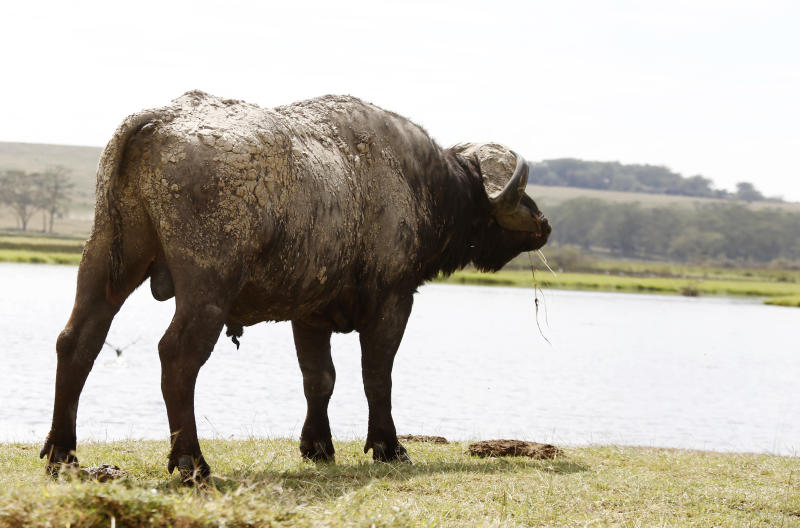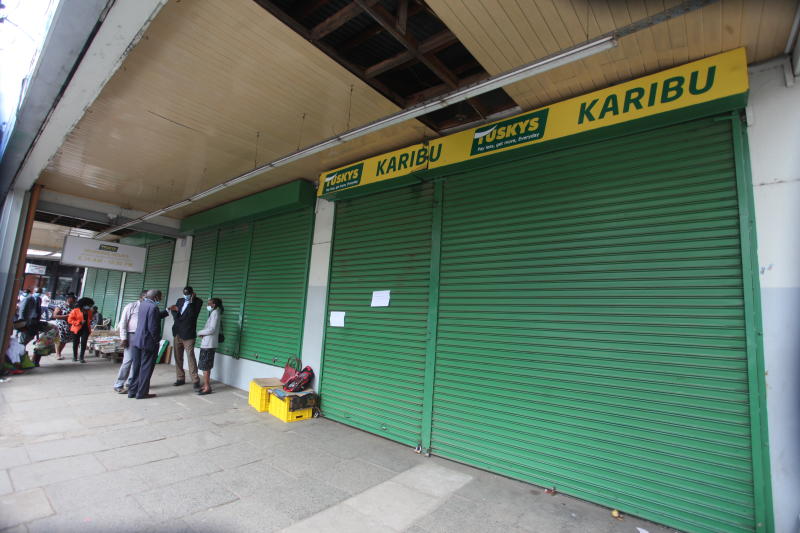 Virus cuts Sh82b from economy in just 6 months
Virus cuts Sh82b from economy in just 6 months

Well-wishers distributing food donations for the vulnerable communities affected by the Covid-19 pandemic at Kuwinda slums, Karen, Nairobi. [Courtesy, Standard]
Kenya posted back-to-back negative growth in the second and third quarters. The latest data from the Kenya National Bureau of Statistics (KNBS) showed that the economy contracted by 1.1 per cent between July and September 2020.
This, however, was a slightly better performance than the previous quarter (April-June) when it shrunk by a revised 5.5 per cent. In the third quarter of 2019, the economy grew by 5.8 per cent.
The numbers have come months late, owing to coronavirus disruptions, according to KNBS.
But experts are divided on whether the two shrinkages amounted to a recession which, if loosely defined, means a contraction of the economy in at least six months or more.
Kwame Owino, an economist and CEO of the Institute of Economic Affairs, a think-tank, stuck to the accepted definition of a recession.
“Hi folks, the accepted definition of a recession is when an economy has had two consecutive quarters of declining GDP,” Kwame posted on Twitter and drew his followers’ attention to the two negative growth rates.
Central Bank of Kenya Governor, Patrick Njoroge, when asked about the recession during the post-MPC press briefing, refused to be dragged into the debate saying he is yet to see the latest data.
Ravage tourism
A Buffalo at lake Nakuru National Park on October 17,2020. [Kipsang Joseph, Standard]
Stringent Covid-19 containment measures aimed at curbing the spread of the pandemic continued to ravage tourism, education, manufacturing, trade and professional services sectors during the third quarter, with all of these sectors shrinking.
“Economic performance in the third quarter of 2020 remained depressed but relatively better compared to the second quarter of 2020,” said KNBS in the Quarterly Gross Domestic Product Report.
Gross domestic product (GDP) is the sum of all goods and services produced in a country or total economic output.
The hospitality industry, arguably the hardest hit sector, shrunk by 58 per cent as hotels remained unoccupied following a slump in international travel as countries closed their borders to contain the disease.
In the same period in 2019, the sector grew by 9.9 per cent.
KNBS noted that activities related to accommodation and food service were adversely affected by the effects of Covid-19 pandemic, which saw the implementation of tough containment measures.
However, the performance in the third quarter was a significant improvement from that of the previous period, between April and July 2020, when accommodation and restaurant activities contracted by 83.2 per cent.
Economist David Ndii noted that while the two quarter-negative-growth is a rule of thumb, the concept was not relevant to Kenya. “We are trying to fit a square peg in a hole,” he said.
He explained that while recessions tend to occur in a business cycle of boom and bust, this has never been the case in the local economy.
“It is not a cycle, because recessions are cyclical. If you are talking about recessions and recoveries, we should be able to go back 50 years and show previous recessions,” Ndii said.
Ken Gichinga, the chief economist at consultancy firm Mentoria Economics, agreed this is not a normal business cycle as the negative growth had been made artificially.
According to Gichinga, immediately “businesses re-open, hotels re-open… things will go back to normal.”
“But in the normal boom and bust cycles, you have exhausted a particular business model even if you give a business more time, it will not recover,” Gichinga said.
Joy Kiiru, economics lecturer at the University of Nairobi, reckons that in a recession, there has to be persistent fall in GDP, accompanied by a persistent high unemployment and persistent fall in interest rates.
In a typical recession, said Kiiru, there is an excess supply of goods and services which are not being consumed. This, she explained, was not the case in the period under review.
In such a scenario, she added, even low-interest rates cannot motivate investment because there is no demand. “The loss in jobs is so big that even if you gave loans at one or three per cent interest rates, the private sector will still not use them because there is no demand,” Kiiru said.
In the second quarter, about 1.7 million people lost their jobs with the unemployment rate standing at 10.4 per cent, using the strict definition of unemployment.
However, in the period under review, the unemployment rate came down to 7.2 per cent after the containment measures were partially lifted, sparking a flurry of economic activities.
Nonetheless, the economic performance in this period points to one of the country’s toughest times since independence, as a health crisis, morphed into an economic one.
Despite the re-opening of the economy, tens of thousands of
businesses remain closed, millions of workers have been laid off or
furloughed, while many people still in employment had their salaries
slashe.
Tuskys Chap Chap on Muindi Mbingu Street closed. [Wilberforce Okwiri, Standard]
President Uhuru Kenyatta’s decision to partially re-open the economy by allowing hotels and restaurants to operate as well as lifting the restriction on domestic and international flights contributed to improved performance of the economy.
With schools still closed during the period under review, education continued its negative performance with the sector contracting by 42 per cent compared to a growth of six per cent in the third quarter of 2019.
However, the performance in the current quarter was a huge improvement from the 56.2 per cent contraction in the period between April and July 2020.
Learning has since resumed and is expected to play an integral role in the recovery of the economy this year, according to the World Bank.
It would have been a disaster for Kenya if it were not for the good rains.
Favourable weather lifted the agricultural sector which grew by 6.3 per cent in the period under review compared to five per cent in the same quarter in 2019.
Increased tea production, exports of fruits and sugarcane production made up for the decline in coffee exports, milk intake, vegetable exports and exports of flowers.




No comments :
Post a Comment